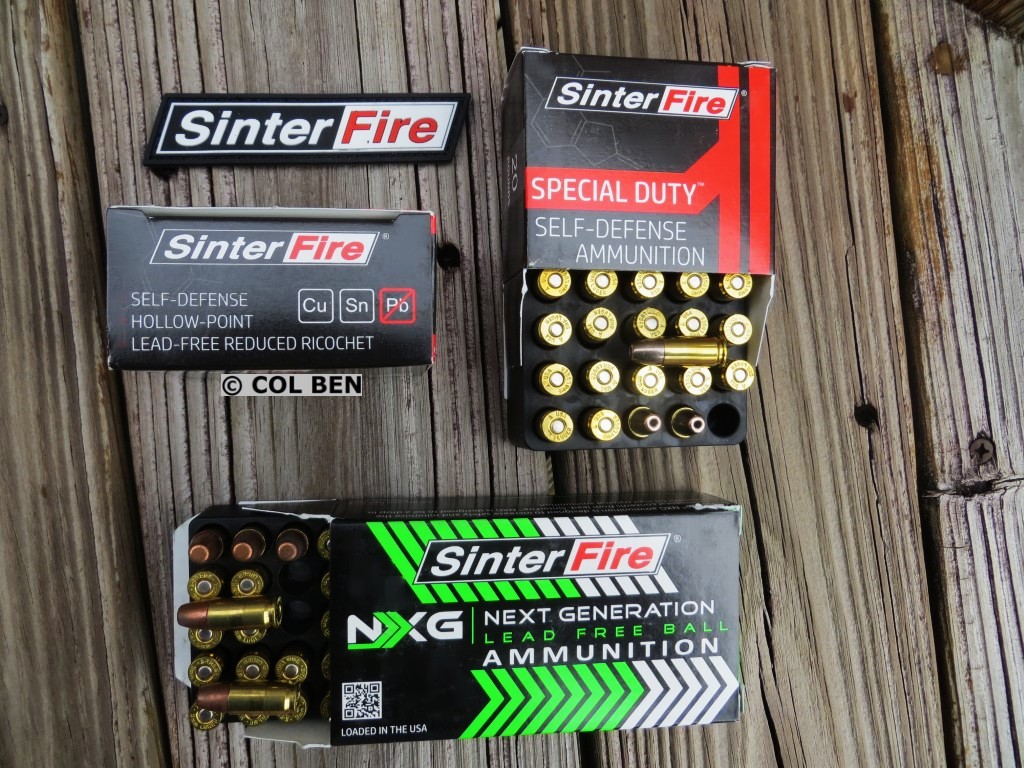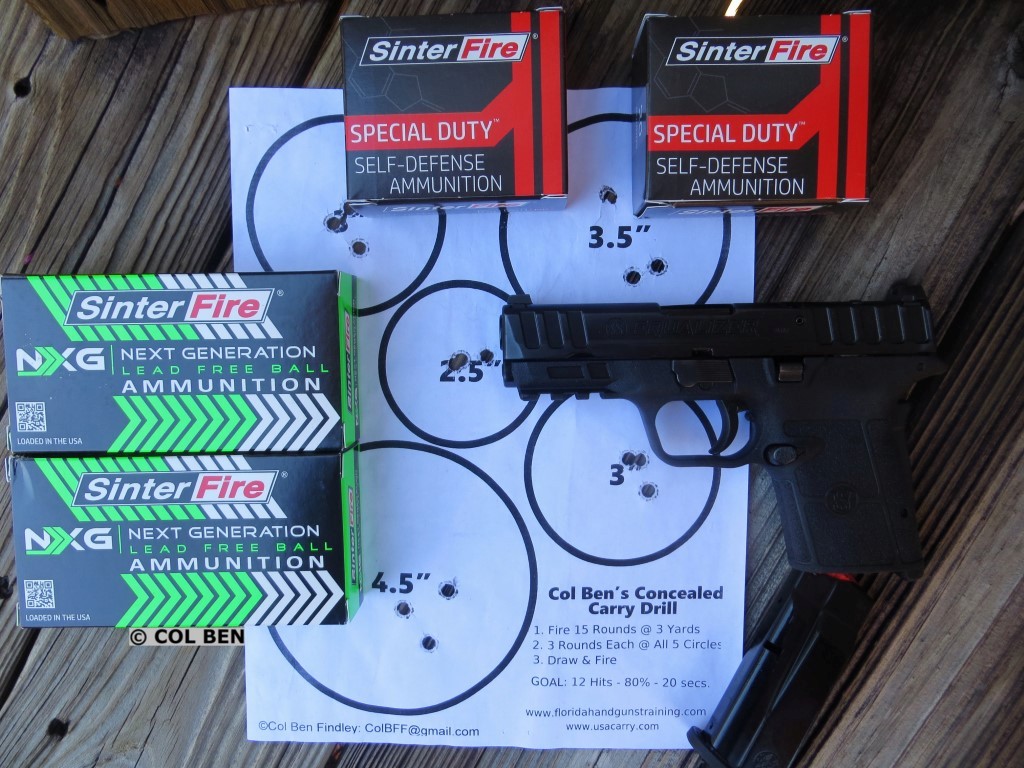The military has used 62 grain 5.56mm RRLP – Reduced Ricochet Limited Penetration – frangible bullets for both CQB live fire practice on steel targets, and ship boarding operations (where unplanned holes in hulls are a bad thing) for a long time. The ballistic gel tests I’ve seen show the ammo should be quite effective if used for home defense.
Frangible Ammo for Self-Defense and Concealed Carry
A Frangible bullet is a projectile that breaks into powder or fragments upon hitting the target and does not penetrate or does not penetrate deeply. Frangible hollow-point bullets may penetrate clothing, drywall, or thin sheet metal but then disintegrate upon striking harder objects like glass. By design, Frangibles often disintegrate into very small particles when impacting the target. These small particles are slowed rapidly by air resistance, so they are less likely to cause injury, death, or damage to people and/or objects upon impact. Frangible bullets are often made of malleable lead and copper and tend to have minimal to no ricochet, especially from hard targets.

Frangibles are different than both FMJ and JHP rounds in that they are not molded out of metal but rather are made from densely-packed metal dust particles.
Powdered metals, like copper, tin, and/or zinc, are compressed at room temperature to make a high-density material. The metal material is bonded together into raw purified metal slugs or blanks or pressed into various shapes. There are various metallurgy techniques used, including heat treating or sintering of the powdered metals. Sintering is the process of compacting and forming solid material by pressure or heat without melting it to the point of it initially becoming a liquid. Frangible bullets are not made from a lead projectile covered with a copper jacket.
Frangible bullets have been around since the middle of the 20th Century, used mostly in shooting galleries than for their safety features. Some do not understand them and have not discovered the benefits of using them. Not all Frangibles are the same. Different materials, binding agents, and processes are used. For example, Inceptor uses polymer, rather than tin, as the binding agent and is identified by its dark brown color and fluted ARX bullet. Some have a lead Frangible core and polymer case. I have used several Frangible types, and I have found SinterFire, Inc. to make high-quality copper and tin Frangibles. SinterFire makes lead-free, frangible projectile bullets for pistols, rifles, and shotguns. Their projectiles are manufactured using an exclusive blend of copper and tin composite material and a proprietary heat treatment process. Major ammo manufacturers, like Winchester, Federal, Speer, Remington, Fiocchi, and many others, offer Frangible ammo that use the SinterFire bullet.
Since 1998, SinterFire has been the originator and innovator of this unique technology used by the military, law enforcement, and government organizations, as well as by civilians. Their Frangible ammo is well proven to perform reliably for several uses, like training and hunting. More on the uses below, including self-defense and concealed carry.
Other than Frangible ammo like Sinterfire’s Reduced Hazard and GreenLine ammo, they also make lead-free NXG ball ammo. NXG uses a proprietary blend of materials that provide a ductile, rather than Frangible bullet, that can be cannelured (placing a groove around the cylindrical part of the bullet) and crimped. It is used for training, target shooting, and general range use and is safe for indoor and outdoor shooting.
I have worked with some shooters who believe that lightweight Frangible bullets cannot be accurate. This is not a valid conclusion, although Frangibles are more affected by wind. My experiences tell me that my 9mm caliber guns using Frangibles perform just as accurately or sometimes better than non-Frangibles at distances between seven to twenty yards. I can hit the targets with them, and my gun reviews show this over many years. Below, see my target hits at seven yards with SinterFire Frangibles, as well as with ball ammo. So for me, Frangible ammo is generally not less accurate than traditional ammo. The ammo and its materials, components, jacket or no jacket, the shooter’s skills, the gun itself, and other factors must be considered. My hunting friends tell me that they have used them effectively for hunting everything from large feral hogs, coyotes, and badgers to deer.

By design, Frangible hollow-point bullets may penetrate drywall, sheet metal, clothing, and certain other materials, but some have their doubts. They penetrate and disintegrate when impacting any target harder than the bullet itself. Gel-penetration studies, for example, have shown that SinterFire .380 ACP 75-grain hollow-point Frangibles penetrated an average of about 11 inches. Generally, Frangible rounds have been shown to produce somewhat comparable penetration depth to other bullets. However, with less overall penetration probability.
Frangibles are used for many purposes, including training, hunting, at close range on steel and hard targets, personal protection, and in SWAT training and hostage rescue teams, because of eliminating over-penetration and reducing or greatly avoiding collateral damage to bystanders due to the very low chance of ricochet or backsplash. Some Air Marshals use Frangible ammo that is intended to penetrate and fragment in the body to avoid depressurizing airplane cabins and safety concerns. Consider that Frangibles and their properties might help reduce the risk of legal problems and lawsuits.
Frangible ammo is not just for steel targets and related safety and ricochet concerns, as many believe. Some shooters believe that modern-day Frangibles are just like the poor-performing Frangibles of 30 or so years ago. There have been very significant improvements in technology since then. A main attraction to them is what shooters like in hollow-point bullets… reducing the risk of accidental injuries and collateral damage from over-penetration since Frangibles break apart and fragment on impact. Recognize that some Frangibles still have the capability of penetrating a wall and a bad guy or gal, so research and select the best Frangible ammo for your needs.
Because of their properties, safety, and disintegration characteristics, Frangibles are often used in close-quarters defense situations, such as in schools, hospitals, airplanes, and homes. While they are not for use in every self-defense situation, at least consider them when over-penetration is a goal. Remember, upon impact with a target harder than themselves, like walls, studs, drywall, frames, glass, concrete, lumber, and people, they disintegrate into a powder and do not keep traveling, like traditional rounds. Recall that my experiences tell me that, generally, SinterFire Frangibles penetrate quite well and have proven accurate for me.
Generally, due to their lighter-grain bullets (like 100 grain 9mm), they deliver higher velocity and somewhat less felt recoil. They are less likely to over-penetrate and splashback and greatly reduce the risk of ricochet. Certainly, they help reduce the carry weight of your gun for concealed carry. Another desirable characteristic of Frangibles for Concealed Carry and other uses is the absence of exit wounds, which greatly reduces the risk of unintentional injuries and collateral damage from over-penetration. Remember, the shooter must follow all the rules of gun safety and carry practices and procedures, even with these Frangibles. Needless to say, practice is extremely important with Frangibles and all ammo to learn their characteristics and how they impact and perform.
On August 24, 2012, a gunman shot and killed a former co-worker outside the Empire State Building in Manhattan, New York City. Nine bystanders were wounded by stray bullets and by fragments of ricocheting bullets. Without a doubt, the use of Frangible ammo would have probably produced a different outcome. Frangibles have legal and ethical implications and do help show attention and responsibility for safety. Just knowing that you are carrying and using rounds that perform well against a close threat while offering the safety and peace of mind that you will limit unintended injuries to bystanders is comforting and prudent.
Here are some Questions from students and fellow shooters with some Answers:
Generally, Frangible bullets are lighter than traditional bullets, so they have less felt recoil, especially for new and inexperienced shooters and trainees.
Reduction in penetration does not necessarily mean that Frangibles are not lethal and cannot cause serious damage. Un-armored targets can be impacted and affected.
Yes, several law enforcement agencies use Frangible ammo, e.g., The Federal Law Enforcement Training Center, the FBI, and the U.S. Coast Guard. It is particularly used for training, range practice, steel-target shoots, live-fire shoot houses, and indoor police ranges. Some state police departments use it for qualifications.
SinterFire makes a Special Duty, Lead-Free Frangible 9mm Hollow Point 100-grain Round that sells for about $14. to $17. a box of 20.
When training with Frangible or any bullets, for safety, keep a safe general distance between yourself and the steel target of about 10 yards when shooting a pistol and about 100 yards when shooting a rifle. Most seem to think that shooting steel at about as close as 7 yards or 21 feet is probably safe, but safety first always. Some have told me that they have safely shot at steel from only 12 feet or slightly less away with Frangibles. Of course, the farther the distance, the safer. Minimize risk!
No, usually, there is no metal jacket with Frangibles. They are made from densely-packed metal dust particles. Just a few are jacketed, and some have a polymer case. Shooting jacketed bullets can result in ricochets since the jacket separates from the bullet.
SinterFire supplies about 90 percent of the Frangible bullets, and their copper and tin bullets are lead-free, and the primers are non-toxic. Their bullets have no jacketing, plating, or surface treatments, helping to make them “clean and green.”
Most manufacturers advise against using Frangibles in Suppressors, while others do not. The proper barrel twist rate and using high-quality and properly stabilized ammo are very important. Again, safety comes first, always!
Be Safe and Continued Success!

